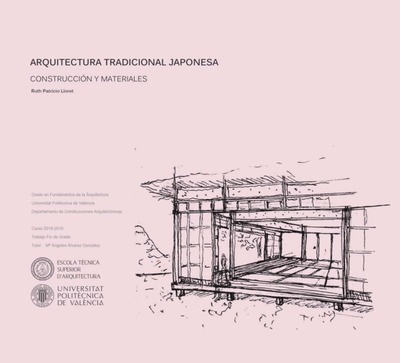JavaScript is disabled for your browser. Some features of this site may not work without it.
Buscar en RiuNet
Listar
Mi cuenta
Estadísticas
Ayuda RiuNet
Admin. UPV
ARQUITECTURA TRADICIONAL JAPONESA. Construcción y materiales
Mostrar el registro sencillo del ítem
Ficheros en el ítem
| dc.contributor.advisor | Álvarez González, Mª Angeles
|
es_ES |
| dc.contributor.author | Patricio Lloret, Ruth
|
es_ES |
| dc.coverage.spatial | east=138.252924; north=36.204824; name=Japó | es_ES |
| dc.date.accessioned | 2020-01-28T10:48:16Z | |
| dc.date.available | 2020-01-28T10:48:16Z | |
| dc.date.created | 2019-09-19 | |
| dc.date.issued | 2020-01-28 | es_ES |
| dc.identifier.uri | http://hdl.handle.net/10251/135826 | |
| dc.description.abstract | [ES] El conocimiento de otras culturas nos enriquece. Una manera de adentrarnos en eses culturas es a través de su arquitectura y en consecuencia, de la manera de construirla. Japón como país asiático nos ofrece una visión distinta a lo que más conocemos como país occidental. El estudio de la vivienda tradicional japonesa nos ofrece la posibilidad de entendimiento de esta cultura, ya que se proyecta para adaptarse a las condiciones climáticas del lugar. Su material principal es la madera y el papel de arroz. A nivel organizativo, el espacio interior se realiza a base de paneles y paredes correderas que dan flexibilidad a las actividades diarias. El uso de materiales ligeros fue la opción tomada a los frecuentes sismos, así como a la enseñanza budista que promulga la ley de lo efímero. La casa japonesa es totalmente reciclable. Este tema quiere ser una puerta abierta a otra concepción de la construcción arquitectónica. | es_ES |
| dc.description.abstract | [EN] The knowledge of other cultures enriches us. One way to get into these cultures is through their architecture and consequently, the way to build it. Japan as an Asian country offers us a different vision to what we know as a Western country. The study of traditional Japanese housing offers us the possibility of understanding this culture, since it is projected to adapt to the climatic conditions of the place. Its main material is wood and rice paper. At an organizational level, the interior space is made up of panels and sliding walls that give flexibility to daily activities. The use of light materials was the option taken to the frequent earthquakes, as well as to the Buddhist teaching that promulgates the law of the ephemeral. The Japanese house is totally recyclable. This theme wants to be an open door to another conception of architectural construction. | es_ES |
| dc.language | Español | es_ES |
| dc.publisher | Universitat Politècnica de València | es_ES |
| dc.rights | Reserva de todos los derechos | es_ES |
| dc.subject | Construcción | es_ES |
| dc.subject | Arquitectura | es_ES |
| dc.subject | Japón | es_ES |
| dc.subject | Building | es_ES |
| dc.subject | Japan | es_ES |
| dc.subject | Architecture | es_ES |
| dc.subject.classification | CONSTRUCCIONES ARQUITECTONICAS | es_ES |
| dc.subject.other | Grado en Fundamentos de la Arquitectura-Grau en Fonaments de l'Arquitectura | es_ES |
| dc.title | ARQUITECTURA TRADICIONAL JAPONESA. Construcción y materiales | es_ES |
| dc.type | Proyecto/Trabajo fin de carrera/grado | es_ES |
| dc.rights.accessRights | Abierto | es_ES |
| dc.description.bibliographicCitation | Patricio Lloret, R. (2019). ARQUITECTURA TRADICIONAL JAPONESA. Construcción y materiales. http://hdl.handle.net/10251/135826 | es_ES |
| dc.description.accrualMethod | TFGM | es_ES |
| dc.relation.pasarela | TFGM\95650 | es_ES |
Este ítem aparece en la(s) siguiente(s) colección(ones)
-
ETSA - Trabajos académicos [4687]
Escuela Técnica Superior de Arquitectura






